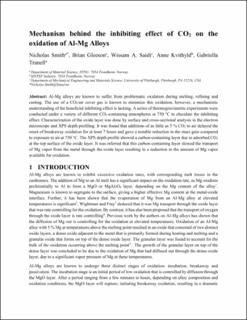Mechanism behind the Inhibiting Effect of CO2 on the Oxidation of Al−Mg Alloys
Peer reviewed, Journal article
Accepted version
Permanent lenke
https://hdl.handle.net/11250/2720956Utgivelsesdato
2018Metadata
Vis full innførselSamlinger
- Publikasjoner fra CRIStin - SINTEF AS [5654]
- SINTEF Industri [1534]
Originalversjon
10.1021/acs.iecr.8b04691Sammendrag
Al–Mg alloys are known to suffer from problematic oxidation during melting, refining, and casting. The use of a CO2/air cover gas is known to minimize this oxidation; however, a mechanistic understanding of the beneficial inhibiting effect is lacking. A series of thermogravimetric experiments were conducted under a variety of different CO2-containing atmospheres at 750 °C to elucidate the inhibiting effect. Characterization of the oxide layer was done by surface and cross-sectional analysis in the electron microscope and X-ray photoelectron spectrometry (XPS) depth profiling. It was found that additions of as little as 5% CO2 to air delayed the onset of breakaway oxidation for at least 7 h and gave a notable reduction in the mass gain compared to that seen upon exposure to air at 750 °C. The XPS depth profile showed a carbon-containing layer due to adsorbed CO2 at the top surface of the oxide layer. It was inferred that this carbon-containing layer slowed the transport of Mg vapor from the metal through the oxide layer, resulting in a reduction in the amount of Mg vapor available for oxidation.
